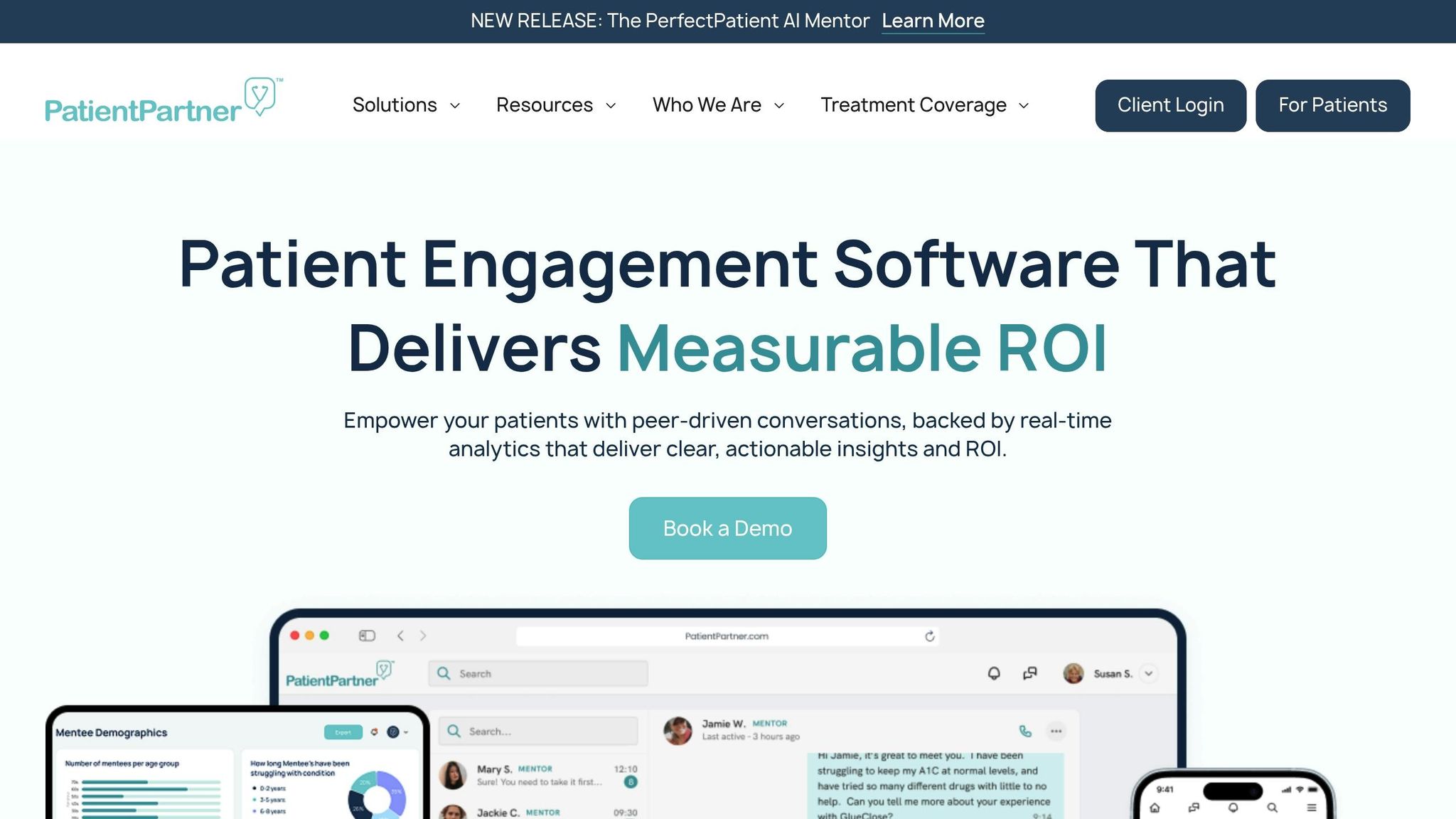Why Sensitivity Training Matters for Diverse Patients


Key Takeaways
Why Sensitivity Training Matters for Diverse Patients
Sensitivity training in healthcare is essential for improving patient care and addressing disparities. It helps providers connect with patients by teaching skills like empathy, communication, and bias recognition. With the U.S. becoming more diverse - projected to have no single racial majority by 2045 - this training ensures care aligns with patients' unique needs, boosting satisfaction, trust, and outcomes.
Key takeaways:
- 96% of studies show implicit bias training improves provider cultural competence.
- Patients treated by trained providers report better satisfaction and health outcomes.
- Hospitals adopting these programs see higher patient satisfaction and reduced costs.
5 Benefits of Cultural Competency in The Healthcare Industry
Research Findings: How Sensitivity Training Affects Patient Outcomes
Studies from across the United States highlight how sensitivity training directly improves patient care. These programs have been linked to higher patient satisfaction scores and better health outcomes, particularly for diverse populations. Healthcare organizations that adopt sensitivity training often report notable progress in addressing disparities and enhancing patient experiences.
Main Benefits of Sensitivity Training
Sensitivity training brings measurable improvements in three core areas: patient satisfaction, trust building, and reducing healthcare disparities.
- Patient satisfaction consistently stands out as a key benefit. Research shows significant improvements in how patients rate their care, especially among minority groups who often face unique challenges in healthcare environments.
- Trust building is another critical outcome. Providers who understand cultural differences and communicate effectively create an environment where patients feel more comfortable sharing personal health details. This trust leads to better clinical results, as patients become more engaged in their care and adhere to treatment plans.
- Reducing healthcare disparities is a vital impact of sensitivity training. By helping providers recognize and address unconscious biases, these programs promote more equitable care. This approach helps close health outcome gaps between different demographic groups, ensuring fairer treatment for all.
The practical benefits for healthcare organizations are also substantial. Patients who feel respected and understood are more likely to return for follow-up appointments and stick to prescribed treatments. This increased engagement not only improves outcomes but also lowers healthcare costs - a clear benefit for both providers and patients.
Statistics and Evidence
The effectiveness of sensitivity training is backed by strong data. For example, a study at a northeastern U.S. hospital found that the "Charm Starr" program significantly improved inpatient satisfaction ratings within just one year.
A broader systematic review of seven U.S.-based studies revealed that five reported statistically significant increases in patient satisfaction following cultural competence training interventions. This consistency across different settings highlights the reliability of these programs in improving patient experiences.
Beyond satisfaction, sensitivity training also enhances health outcomes. Research shows that patients trained under these programs are more likely to access social resources and improve their functional capacity without increasing healthcare costs. These effects are especially crucial for minority and underserved populations, who often face systemic barriers in accessing care.
Experts attribute these results to better communication, reduced bias, and stronger patient engagement. Sensitivity training equips providers with the skills to connect meaningfully with diverse patients, fostering trust and open dialogue that lead to better adherence to treatment plans.
Over time, the benefits of sensitivity training continue to grow. As providers gain experience in recognizing and addressing cultural differences, they build stronger connections with patients. This creates a positive feedback loop: improved communication fosters trust, which leads to better care and outcomes. These findings highlight the critical role sensitivity training plays in delivering patient-centered healthcare.
How Sensitivity Training Improves Patient Experiences
Sensitivity training plays a key role in transforming healthcare by addressing unconscious biases and enhancing communication skills among providers. Together, these changes create more inclusive, welcoming environments that improve care for all patients.
Reducing Implicit Bias and Raising Awareness
Unconscious biases exist in all of us, including healthcare providers, and these biases can subtly shape decisions and interactions. Sensitivity training helps providers become more self-aware, enabling them to identify and minimize the influence of assumptions tied to race, ethnicity, language, or other factors.
Studies spanning over two decades have consistently shown that implicit bias training for healthcare workers leads to better knowledge, improved skills, and more positive attitudes. For example, when physicians and patients share similar backgrounds, health outcomes - such as lower infant mortality rates - often improve. Even in cases where shared backgrounds aren’t possible, sensitivity training helps bridge differences, encouraging a fairer and more inclusive approach to care. This heightened awareness fosters more respectful and effective interactions between providers and patients.
Strengthening Communication and Empathy
Addressing bias is just the starting point. Sensitivity training also focuses on improving communication, which is essential for building trust and ensuring patients fully understand their diagnoses and treatment options. A key aspect of this training includes using professional interpreters to overcome language barriers, ensuring patients feel understood and supported.
Empathy training takes this a step further by teaching providers how to truly listen and respond to patients’ concerns. When patients feel heard and respected, trust grows, leading to better collaboration. This approach emphasizes shared decision-making that honors patients’ cultural values and personal preferences, creating care plans that genuinely align with their needs.
Research backs up these benefits, showing that sensitivity training enhances patient satisfaction and engagement. Improved communication and empathy strengthen provider-patient relationships, encouraging patients to stay involved in their care and follow treatment recommendations. These positive changes contribute to better health outcomes overall, benefiting both patients and healthcare systems alike.
sbb-itb-8f61039
How to Implement Sensitivity Training Programs
Sensitivity training plays a crucial role in enhancing patient care. To make a real impact, these programs should be customized to meet the unique needs of different patient populations and healthcare providers, moving away from a one-size-fits-all approach.
Key Elements of Effective Programs
Continuous education is a must. Sensitivity training shouldn't be a one-time event. Instead, it should include regular refresher courses tied to performance evaluations. This ongoing approach helps healthcare providers consistently improve their ability to interact with diverse patient groups over time.
Role-specific training ensures that the material is relevant and practical. For instance, front-line staff handle patient interactions differently than specialists or administrative teams. Conducting a needs assessment can help identify the priorities for each group. For example, urban hospitals might focus on addressing language barriers and interpreter services, while rural clinics may emphasize socioeconomic challenges and limited resources.
Alignment with organizational policies and values makes sensitivity training more impactful. Leadership plays a big part here by not only supporting the training but also participating in it and modeling the desired behaviors. When training is tied to broader goals like quality improvement and patient care standards, it becomes embedded in the organization's culture rather than feeling like an isolated task.
Ongoing feedback and evaluation are critical for tracking progress. Tools like patient satisfaction surveys, provider self-assessments, and pre- and post-training health outcome measurements can help identify areas for improvement. These data-driven insights allow for continuous program adjustments and demonstrate how sensitivity training can directly benefit patient care.
Next, explore the various training methods to find the right fit for your organization.
Training Methods: Comparing Your Options
Healthcare organizations can choose from several training methods, each with its own strengths and limitations. The best option depends on factors like budget, reach, and the desired impact.
| Training Method | Cost | Reach | Impact on Knowledge & Attitudes | Behavioral Change | Flexibility |
|---|---|---|---|---|---|
| In-person Workshops | High | Limited | High | Moderate-High | Low |
| Online Synchronous | Moderate | Moderate | High | Moderate | Moderate |
| Online Asynchronous | Low | High | Moderate-High | Moderate | High |
| Virtual Reality | High | Moderate | High | Moderate | Moderate |
| Mentorship/Peer Support | Moderate | Moderate | High | High | Moderate |
In-person workshops are great for fostering interaction and building interpersonal skills. They encourage group discussions and hands-on learning, but they come with higher costs and time commitments, which can limit participation.
Online training options offer more flexibility. Asynchronous modules let staff complete training at their own pace, while synchronous sessions include some live interaction. A 2024 review of 23 studies showed that online diversity training improved healthcare workers' knowledge, self-efficacy, and ability to address biases. These methods are also more scalable, making them ideal for reaching larger groups at lower costs per participant.
Mentorship and peer support programs stand out for their ability to create lasting behavioral changes. By providing ongoing guidance and real-world application opportunities, these methods extend the benefits of training well beyond the initial sessions. This approach directly supports improvements in patient satisfaction, as discussed earlier.
For the best results, combine multiple methods to address different learning styles and overcome potential challenges. Research shows that longer, more intensive programs are far more effective than brief, one-off sessions. A blended approach ensures comprehensive learning experiences that cater to various needs and constraints.
Of course, challenges such as staff resistance, time limitations, and resource constraints can arise. These obstacles can be mitigated by demonstrating the program's value with data, offering flexible training formats, and recognizing staff participation. Involving employees in the program design and using examples relevant to their daily work can also boost engagement and practical application.
Case Study: PatientPartner and Real-Time Mentorship in Sensitivity Training

Sensitivity training is an essential tool for helping healthcare providers better serve diverse patient populations. However, traditional methods sometimes fall short of addressing the nuanced challenges providers face. PatientPartner steps in to close this gap with a mentor-driven platform that connects patients to experienced mentors who have navigated similar healthcare journeys. This unique approach enhances sensitivity training by adding a layer of real-world mentorship, making the training more impactful.
Combining Mentorship with Training
PatientPartner takes sensitivity training a step further by pairing it with personalized patient support. The platform matches patients with mentors who share similar cultural, linguistic, or personal experiences, creating meaningful connections. This tailored approach helps address the specific concerns that sensitivity training highlights but may not always have the time to address thoroughly in a clinical setting.
Here’s the impact: 68% of patients who engage with a mentor are more likely to begin their prescribed treatment, and 90% report feeling more confident about their care journey. These numbers highlight how mentorship can reinforce the trust and communication skills that sensitivity training aims to build in healthcare providers.
For example, consider a Spanish-speaking patient newly diagnosed with diabetes. PatientPartner pairs them with a bilingual mentor who has successfully managed diabetes while respecting cultural dietary habits and family dynamics. The mentor offers practical advice, simplifies medical instructions, and provides emotional support beyond the clinical visit. This approach has led to a 29% increase in adherence and extended treatment duration by an average of 133.5 days.
Mentorship like this helps bridge cultural and language gaps that sensitivity training alone might not fully address. While providers learn to recognize these barriers, mentors with lived experience can offer relatable, actionable guidance. This peer-to-peer connection fosters a sense of understanding and support that complements the skills providers develop during training. Together, these efforts create a more holistic approach to patient care.
Using Data and Analytics for Better Results
PatientPartner doesn’t just rely on mentorship - it incorporates real-time analytics to refine and enhance support strategies. This data-driven approach ensures the program adapts to patient needs while staying compliant with strict privacy regulations.
By analyzing sentiment data from patient-mentor interactions, the platform identifies trends in satisfaction, engagement, and treatment adherence. Unlike traditional surveys that provide a snapshot of patient feedback, PatientPartner’s analytics track sentiment throughout the entire care journey. This continuous monitoring offers healthcare organizations insights that static feedback methods often miss.
The results are clear: Organizations using PatientPartner have seen a 30% boost in treatment adoption rates and a 20% improvement in adherence within the first year. These outcomes help pinpoint what’s working and reveal areas where sensitivity training might need adjustment.
Security is a top priority. The platform adheres to HIPAA, SOC 2, and ISO 27001 standards, ensuring patient data remains protected. All analytics are conducted on anonymized data with strict access controls, allowing organizations to improve care quality without compromising confidentiality.
This data-driven model allows healthcare organizations to refine their training and mentorship programs continuously. For instance, if analytics reveal that patients from specific backgrounds struggle with adherence, training programs can be updated to address these challenges. Similarly, mentor-matching algorithms can be fine-tuned to improve compatibility and engagement.
Conclusion: Sensitivity Training as a Foundation of Patient-Centered Healthcare
Sensitivity training plays a crucial role in delivering fair and patient-centered care, especially in today’s diverse healthcare environments. Providers who undergo this type of training show better understanding of different cultures, improved communication skills, and a reduction in unconscious biases - all of which are key to effectively treating patients from various backgrounds.
In fact, 96% of studies on implicit bias training for healthcare professionals report positive changes in knowledge, skills, and attitudes. These improvements translate into tangible benefits for patients, including higher satisfaction rates and better health outcomes - particularly among underserved or diverse populations. For healthcare organizations, sensitivity training isn’t just an ethical choice; it’s also a smart investment that delivers measurable results.
By addressing unconscious biases, sensitivity training helps reduce healthcare disparities and fosters an environment where every patient feels valued and understood. This is especially important in the United States, where increasing racial, ethnic, and cultural diversity coincides with persistent health inequities.
The benefits of sensitivity training are further amplified by innovative tools and platforms. For example, integrating technology like PatientPartner takes training beyond the classroom. By pairing provider education with real-time patient mentorship, these platforms fill gaps that traditional training might miss. The 68% rise in treatment initiation rates seen with PatientPartner’s mentor-driven model highlights how technology can enhance the real-world application of training.
Sensitivity training also helps healthcare organizations meet regulatory requirements, improve patient satisfaction, and thrive under value-based care models that prioritize outcomes and experiences. As equity and patient-centered care remain central to healthcare’s evolution, sensitivity training continues to be a vital strategy for building trust, improving communication, and ensuring that all patients receive the respectful and effective care they deserve.
The journey doesn’t end with a single training session. Healthcare leaders must commit to ongoing investment in evidence-based programs, regular competency assessments, and innovative tools that provide continuous support throughout the patient care process. This sustained focus ensures the healthcare system can consistently deliver equitable and compassionate care to every patient, regardless of their background or circumstances.
FAQs
How does sensitivity training help reduce healthcare disparities in diverse patient populations?
Sensitivity training is an important tool in tackling healthcare disparities. It helps healthcare providers develop the skills to understand and respect the cultural, linguistic, and personal differences of their patients. This not only improves communication but also builds trust, making patients feel acknowledged and valued throughout their care experience.
When healthcare teams create a more inclusive and compassionate environment, patient satisfaction tends to improve. More importantly, it can lead to better health outcomes, especially for underserved or marginalized communities. Sensitivity training helps close gaps in care and ensures that all patients receive fair and respectful treatment, no matter their background or circumstances.
What makes a sensitivity training program effective in healthcare?
An effective sensitivity training program in healthcare aims to build empathy, awareness of diverse backgrounds, and strong communication skills among professionals. Here’s what it typically includes:
- Learning about diverse backgrounds: This helps address unconscious biases and promotes a deeper understanding of patients' cultural, social, and personal contexts.
- Interactive exercises like role-playing: Practicing real-life scenarios allows healthcare workers to refine respectful and inclusive approaches to patient care.
- Ongoing sessions and feedback: Regular training ensures teams stay equipped to meet the changing needs of patients and maintain a high standard of care.
When healthcare professionals are equipped with these tools, the results can be transformative: improved patient satisfaction, better health outcomes, and stronger, trust-filled relationships between patients and providers.
How can healthcare providers evaluate the effectiveness of sensitivity training on patient satisfaction and health outcomes?
Healthcare providers can measure the effectiveness of sensitivity training by monitoring important metrics like patient satisfaction scores, treatment adherence rates, and health outcomes over time. Gathering feedback through patient surveys and examining data trends can reveal how well these initiatives are working and highlight areas for improvement.
Tools such as PatientPartner can play a key role in these efforts. By providing real-time patient mentorship and support, platforms like this help organizations boost patient engagement and see tangible improvements in results.
Author

Lidia Chesnokova, VP of Client Success at PatientPartner, drives patient engagement software strategy and personalized support solutions in healthcare.







